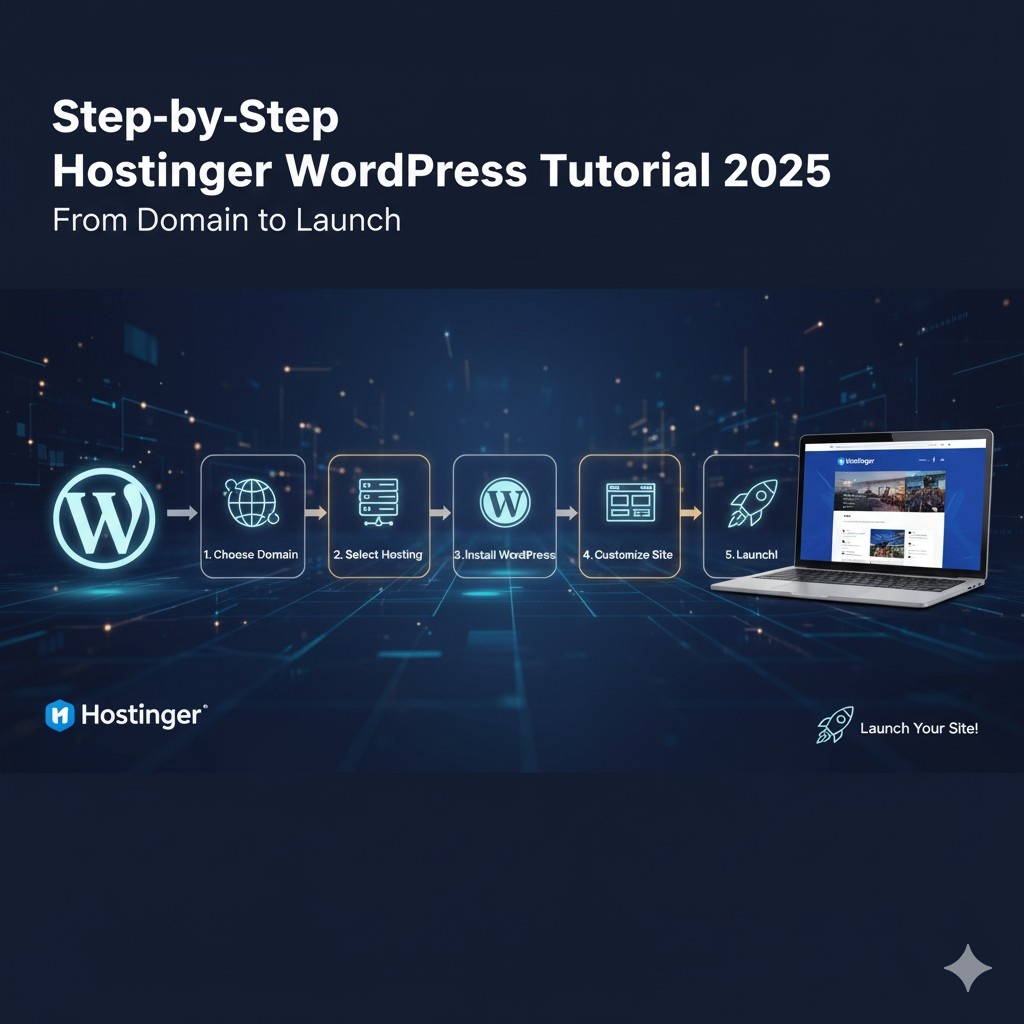Building a website in 2025 doesn’t have to be complicated, even if you’re a beginner. With Hostinger WordPress hosting, you can go from zero to a fully functional website quickly, without any coding experience. This step-by-step Hostinger WordPress tutorial will guide you through everything — from choosing your domain and installing WordPress to launching your site and optimizing performance.
Plus, if you’re a first-time user, you can save with a hostinger coupon code for first time user (DealsZo provides the latest coupons and discount codes), making it easier than ever to start your online journey.
Before you begin, it helps to understand why Hostinger + WordPress make a solid combination. Hostinger offers affordable, fast hosting, with one‑click WordPress installation and optimized servers. WordPress remains the world’s most popular content management system, powering nearly 40‑60% of all websites.
In 2025, using WordPress hosting with Hostinger means you get:
- A domain registration option and SSL certificate included.
- Easy management via Hostinger’s hPanel (control panel) for WordPress hosting.
- Access to thousands of WordPress themes and plugins.
- Strong performance, especially if you optimize correctly (we’ll cover that).
Pairing this with AI‑powered tools like ChatGPT, Microsoft Copilot or Perplexity for research/content ideas, means you can build your website faster and smarter.
Now, let’s walk through the full step‑by‑step process.
Log in to Hostinger and browse their WordPress hosting plans. For beginners, choose a plan labelled “WordPress Hosting” or “Managed WordPress Hosting”. Ensure it supports WordPress and provides enough storage, bandwidth, and free domain if available.
When you sign up, apply your “hostinger coupon code for first time user” (40 words mention) so you save on your first term. DealsZo often supplies the latest coupons and discount codes for Hostinger, so check there before checkout.
As part of the process you will either register a new domain (e.g., mysite2025.com) or use an existing one. Make sure your domain is easy to remember, brand‑friendly, and ideally ends with .com for USA audiences.
Before moving on:
- Make sure SSL is enabled (so you have HTTPS).
- Your WordPress hosting plan supports one‑click WordPress install.
- Your plan provides automatic updates, backups or at least easy manual backups.
Great — once everything is purchased and ready, we go to installation.
In Hostinger’s hPanel (or dashboard), go to Websites → Auto Installer (or WordPress section) and select WordPress.
Provide: site name, admin username, password, language. Choose version (use latest). Hostinger will install WordPress for you.
If the auto‑installer doesn’t fit your needs, you can upload WordPress manually: download the files from WordPress.org, upload via File Manager or FTP, create database and user, then run the install script. Hostinger’s guide covers this.
After install, log in to your WordPress dashboard (usually yourdomain.com/wp-admin). This is where you’ll build your site, install themes and plugins, publish posts/pages.
In WordPress dashboard → Settings → General: configure site title, tagline, timezone, language.
Go to Settings → Permalinks and choose “Post name” to ensure clean, SEO‑friendly URLs.
Navigate to Appearance → Themes → Add New. Browse free themes or upload a premium one if you have it. Make sure to choose a responsive theme (mobile‑friendly) and one optimized for speed.
Go to Plugins → Add New and consider installing:
- Cache plugin (for speed)
- Security plugin (for safety)
- SEO plugin (for optimization)
- Backup plugin (for safety)
- Page builder if you want drag & drop (like Elementor)
WordPress hosting through Hostinger supports these functions well.
Create key pages: Home, About, Services/Products, Blog, Contact. Then build your navigation menu via Appearance → Menus.
Since we’re optimizing for 2025, let’s integrate AI. Tools like ChatGPT, Microsoft Copilot and Perplexity can help you generate draft text, titles, meta descriptions, keyword suggestions, blog post ideas. They save time and reduce writer’s block.
Use ChatGPT to ask: “Generate 500‑word blog post outline about topic X for WordPress site.” Then refine and incorporate your unique branding.
Perplexity is helpful for quickly pulling up factual information, statistics, references, and summarizing web content. Use it to research “average WordPress site load time in 2025”, or “WordPress plugin compatibility issues” etc.
If you use WordPress block editor, Microsoft Copilot may integrate to help you write longer posts or generate headings, content blocks, etc.
Plan your blog posts and pages:
- Use your keyword “WordPress hosting” and “Hostinger tutorial” naturally in headings and paragraphs.
- Ensure readability: short paragraphs, bullet points, sub‑headings.
- Use images, alt text for SEO.
- Make internal links (link to your other pages/posts).
A fast website is crucial. Google and users dislike slow sites. Here’s how you optimize WordPress on Hostinger.
Avoid bloated themes. Use one built for speed, minimal code, optimized CSS/JS.
Install a caching plugin (for example, LiteSpeed Cache, WP Super Cache, etc). Enable minification of CSS/JS, browser caching.
A CDN will serve your static content from servers closer to your visitors, which improves load time. Hostinger supports CDN integration or you can connect to Cloudflare.
Compress images before upload (via tools or plugins), use WebP format, use lazy loading (images load as user scrolls).
Too many plugins slow your site. Only install essential plugins, keep them updated, and remove inactive ones. Hostinger’s WordPress tutorial mentions this.
Make sure your hosting has up‑to‑date PHP version (7.4+ or preferably 8.x) and update WordPress core, themes, and plugins regularly for compatibility and performance.
Keeping your WordPress site secure is essential to protect your brand and visitors.
Avoid “admin” usernames, use strong passwords, enable two‑factor authentication (2FA) if possible.
Set up automatic backups (daily or weekly) via plugin or Hostinger’s backup service.
Themes, plugins, WordPress core should be updated promptly to patch vulnerabilities.
Consider installing WordFence, Sucuri, or similar for firewall, malware scanning, login protection.
Ensure the site is running under HTTPS (Hostinger usually offers free SSL).
Review user roles, monitor suspicious login attempts, keep an eye on plugin/theme changes.
Before launching your WordPress website, run through this checklist:
- Site title and tagline are correct.
- Permalinks are set to “Post name”.
- SEO plugin configured and sitemap generated.
- Robots.txt and Meta robots tags set if needed.
- Home page, About, Contact, Blog pages created and linked.
- Mobile responsiveness tested (desktop & mobile).
- Speed test passed (use Google PageSpeed Insights or GTmetrix).
- Analytics tracking installed (e.g., Google Analytics).
- Necessary cookies/consent plugins in place (for USA users check privacy compliance).
- Backup and security plugin active.
- All links work, no broken pages.
- You’re ready to announce your launch!
Now you’re ready to make your site live:
- Remove any “Coming Soon” or “Maintenance Mode” page.
- Set your site to public (Settings → Reading → uncheck “Discourage search engines”).
- Announce on your social profiles, email list if you have one.
- Monitor the initial traffic, check for errors in Google Search Console.
- Begin your content strategy: publish consistent blog posts, update pages, promote.
Your work doesn’t end at launch. To keep momentum:
- Add new blog posts regularly (e.g., weekly or biweekly) guided by keyword research.
- Use tools like ChatGPT, Perplexity and Copilot to generate ideas and speed content creation.
- Monitor site performance every month.
- Update WordPress core, themes, and plugins regularly.
- Check for broken links, optimize older posts, refresh content.
- Use email marketing, social sharing, guest posting to build traffic.
- Stay secure: monitor login activity, backups, updates.
Once your site is stable, you might want to add advanced features:
- Add an eCommerce section via WooCommerce (WordPress plugin) if you plan to sell products.
- Use membership or subscription systems.
- Add custom post types for portfolios or case studies.
- Optimize for conversion: improve layout, calls to action, A/B test.
- Use advanced caching, server‑level optimisation, or upgrade hosting plan.
- Explore multi‑language support, accessibility, advanced SEO.
What is WordPress hosting and why is it different?
WordPress hosting is a web hosting service specifically optimized to run the WordPress CMS — it may include one‑click installation, automatic updates, caching, better performance and specialist support.
Can I use WordPress on Hostinger with no technical experience?
Yes — Hostinger’s one‑click WordPress installation and user‑friendly hPanel make it accessible to beginners. With this tutorial you don’t need coding skills.
How long does it take to launch a WordPress site on Hostinger?
If you follow the steps: choose plan + domain, install WordPress, set theme & plugins, add content — you could go live in under 1 hour for a basic website. More advanced features take longer.
Do I need to use AI tools like ChatGPT, Perplexity, Copilot?
No, but they can significantly speed up content creation, research and site building. They are helpful to make your WordPress site creation smarter and faster in 2025.
What kind of discount can I get for using Hostinger?
As a first‑time user you can apply a hostinger coupon code for first time user to get reduced pricing or extra benefits. DealsZo tracks the latest coupons and discount codes, so check there before checkout.
How do I ensure my WordPress site runs fast and smoothly?
Use a lightweight theme, enable caching, use a CDN, optimise images, update PHP version, limit unnecessary plugins, and run speed tests regularly.
How secure is WordPress on Hostinger?
Hostinger provides secure infrastructure and you can enhance it with strong passwords, 2FA, backups, security plugins and updates. The responsibility for site security is shared between you and the hosting provider.
Can I scale my WordPress site later?
Absolutely. You can upgrade your Hostinger plan, add eCommerce functionality, membership systems, more traffic capacity, and advanced tools.
Building your website with Hostinger and WordPress in 2025 is straightforward and smart — especially when you follow a clear, step‑by‑step process, use the right keywords like “WordPress hosting”, “install WordPress”, and “Hostinger tutorial” naturally, and take advantage of AI‑powered tools like ChatGPT, Perplexity, and Copilot to save time.
From choosing your domain and plan, installing WordPress, setting up your theme and plugins, optimizing speed and security, to launching and maintaining your site — you now have a complete roadmap. Just remember to apply your first‑time user discount code, use DealsZo to check for latest coupons, keep your site fresh, and keep learning.
Go ahead and take action: buy your plan, install WordPress, publish your first page — and you’ll have a live website ready for your audience in no time. The internet is waiting for your voice.
Good luck, and happy website building!
Read Also: https://techu.blog/

